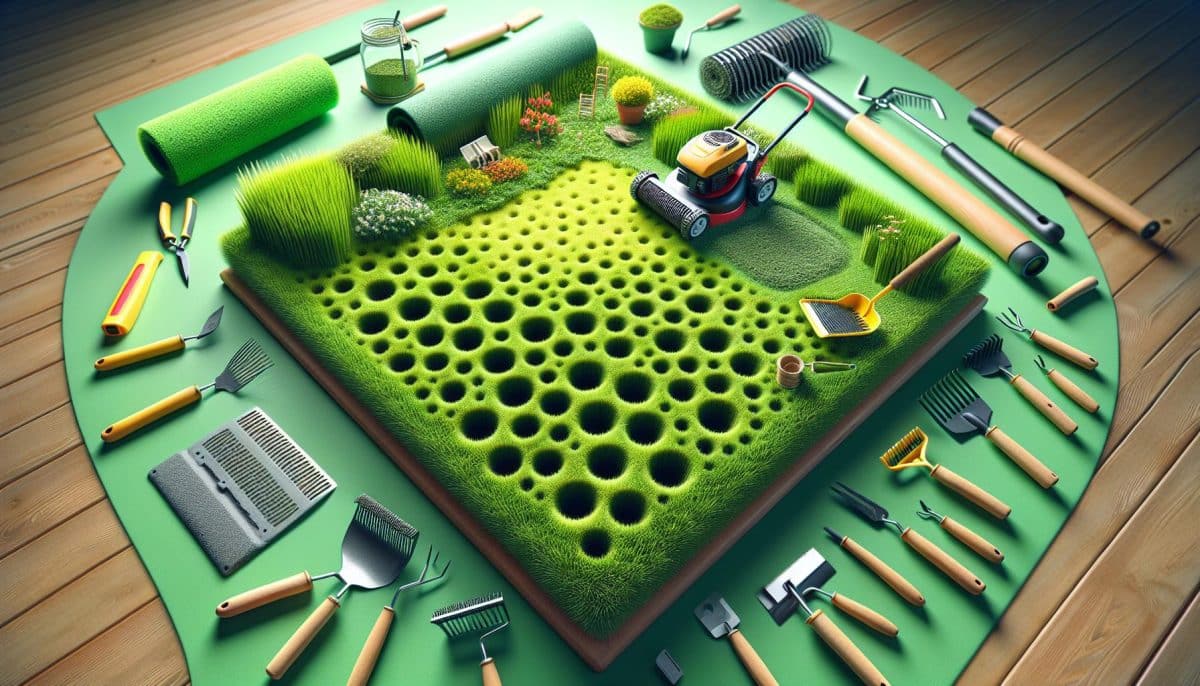
Overseeding your lawn is often touted as a miracle cure for all your grass woes, from thinning patches to seasonal colour fades. But is it really the panacea it’s made out to be, or could there be downsides to this popular gardening practice? With homeowners striving for the perfect lawn, the technique of overseeding has become a go-to, promising lush, thick grass without the hassle and expense of starting from scratch.
But, before you jump on the overseeding bandwagon, it’s crucial to understand not just the benefits but also the potential pitfalls. Could overseeding actually do more harm than good to your cherished green space? Let’s investigate into the heart of the matter and uncover the truth behind overseeding your lawn.
Pros and Cons of Overseeding Your Lawn
Overseeding your lawn is a gardening technique that, when done correctly, can profoundly transform the appearance and health of your turf. It’s an approach often recommended for repairing thinning lawns or introducing hardier grass varieties. While the benefits can be substantial, it’s also essential to be aware of potential drawbacks. Let’s investigate deeper into the pros and cons of overseeding your lawn.
Benefits of Overseeding
Improved Lawn Density and Appearance
One of the primary advantages of overseeding is the notable improvement in your lawn’s density and overall appearance. Introducing new grass seeds into existing turf fills in thin and bare patches, contributing to a lush, vibrant green lawn.
- Enhanced Turf Health: Overseeding promotes a more robust grass stand that’s better equipped to resist pests, diseases, and environmental stresses. By diversifying the grass species through overseeding, you’re essentially bolstering your lawn’s resilience.
- Drought and Heat Tolerance: New grass varieties often come with improved drought and heat resistance. Overseeding with these selections can significantly enhance your lawn’s ability to withstand harsh weather conditions, maintaining its greenery even during dry spells.
- Weed Suppression: A dense, healthy lawn leaves little room for weeds to establish. By overseeding, you’re not just revitalizing your lawn but also creating a natural barrier against weed invasion.
- Seasonal Adaptability: For lawns in regions with distinct seasons, overseeding with cool-season grasses in the fall can ensure your yard remains green through the winter months when warm-season grasses go dormant.
Drawbacks of Overseeding
While overseeding is laden with benefits, it’s not without its challenges. Awareness of these potential downsides can ensure you’re well-prepared to tackle them.
- Time and Effort: Proper overseeding requires significant preparation, including soil aeration, mowing, and thorough watering. This process demands time and physical effort, which may be a consideration for those with a busy schedule or physical constraints.
- Risk of Overcrowding: There’s a fine line between the ideal seed rate and overdoing it. Applying too much seed can lead to overcrowding, where new grasses compete for limited resources, potentially hampering their ability to establish and thrive.
- Water Requirements: Newly overseeded lawns need frequent watering to aid germination and establishment. This requirement can significantly increase your water usage, which might not be feasible in areas with water use restrictions or for those seeking to conserve water.
- Environmental Considerations: It’s crucial to choose the right type of grass seed that matches your local climate and soil conditions. Failing to do so can lead to poor germination rates and wasted effort, not to mention the environmental impact of introducing non-native species that may not thrive in your area.
Investment: Although overseeding is generally less expensive than laying new turf, there is still an
Best Practices for Overseeding Your Lawn

Discovering the optimal approach to overseeding your lawn is pivotal for achieving a thick, vibrant, and resilient turf. Employing the right techniques ensures that your efforts don’t go in vain. Here’s a comprehensive guide on how to get the best results from overseeding.
Timing and Season
Timing is Everything: The success of overseeding largely hinges on choosing the right moment. For most temperate regions, early autumn is the ideal time. This period offers a sweet spot with warm soil that encourages seed germination, alongside cooler air temperatures that support new grass growth. Autumn also has the advantage of reduced weed competition, allowing your new seeds to establish without undue stress.
Understanding Your Climate: If you’re in a warmer climate, overseeding might be more successful during late spring. This ensures the soil temperature is not too high to impede germination. Keep a close eye on local weather conditions and avoid periods of extreme weather that could hamper growth.
Seed Selection
Opt for Quality and Compatibility: Not all seeds are created equal. Select high-quality seeds that are well-suited to your existing lawn and local climate. If your lawn hosts a variety of grass types, consider a blend that complements the existing turf. For example, a mixture of ryegrass, fescue, and bluegrass often works well in cooler climates, offering a balance of qualities.
Understanding Seed Labels: It’s essential to read seed labels carefully. They provide vital information on the seed type, germination rates, and the presence of any unwanted contents such as weed seeds. Ideally, seek out seeds with a high purity and germination rate, ensuring that your overseeding project isn’t compromised by low-quality inputs.
Preparation and Maintenance
Aerate for Success: Aerating your lawn before overseeding is crucial. This process involves creating small holes in the soil to enhance air, water, and nutrient penetration. Aerating alleviates soil compaction, providing an ideal bed for new seeds to germinate and grow. For best results, use a plug aerator capable of extracting cores of soil, so improving seed-to-soil contact.
Topdressing and Watering: Applying a thin layer of topdressing can significantly improve seed soil contact. Choose a material that matches your soil structure to enhance growth conditions. Following overseeding, ensure the lawn is watered deeply, yet gently, to encourage seed germination without causing erosion. Maintaining a consistent watering schedule is vital until the new grass is established and capable of withstanding regular lawn activities.
Mowing and Fertilization: Mow your lawn to a lower height before overseeding. This reduces competition for light and nutrients, allowing new seedlings to flourish. Post-germination, wait until the grass has reached a sufficient height before the first mow to avoid pulling out tender seedlings. Incorporating a starter fertilizer with the correct balance of nutrients can also give your overseeded lawn the boost it needs to thrive.
By adhering to these practices, you’re setting the stage for a successful overseeding project that revitalizes your lawn, enhancing its density, appearance, and resilience. Remember, patience and consistent care are your best allies in nurturing a lush, green world.
Alternative Methods to Overseeding

In the quest for a lush, vibrant lawn, overseeding is often touted as a go-to strategy. But, it’s not the only way to achieve that green paradise you’re dreaming of. There are alternative methods that can rejuvenate your lawn, each with its unique benefits. Understanding these alternatives can help you make an well-informed choice that best suits your lawn’s needs and your personal preferences.
Aeration and Dethatching
Aeration is a process that involves making holes in the lawn to allow air, water, and nutrients to penetrate the grass roots. This helps the roots grow deeply, producing a stronger, more vigorous lawn. The best time to aerate your lawn is during the growing season, when the grass can heal and fill in any open areas after soil plugs are removed. Typically, this means early spring or autumn for cool-season grasses, and late spring through early summer for warm-season types.
Why Aerate?
- Improves air exchange between the soil and atmosphere
- Enhances water and nutrient uptake
- Helps reduce water runoff and puddling
- Encourages stronger root systems
- Breaks up soil compaction
Equipment for Aeration: You can use a spike aerator, which pokes holes in the ground, or a plug aerator, which removes a core or plug of grass and soil. Plug aerators are generally more effective, especially for alleviating compaction.
Dethatching, on the other hand, involves the removal of thatch, a layer of dead grass shoots, stems, and roots that builds up between the soil surface and the live grass blades. While some thatch is beneficial, too much can prevent water, nutrients, and air from reaching the soil and can encourage pests and diseases.
When to Dethatch?
- Thatch more than ½ inch thick is a sign that dethatching may be necessary.
- The best time for dethatching is when your lawn is growing most vigorously—spring for cool-season grasses and late spring through early summer for warm-season grasses.
- Improved nutrient penetration
- Better water absorption
- Enhanced oxygen exchange between the soil and air
- Reduction in pest and disease problems
Conclusion
While overseeding has its place in lawn care, it’s clear that exploring other methods like aeration and dethatching can significantly enhance the health and appearance of your lawn. By adopting these techniques, you’re not just patching problems temporarily; you’re investing in the long-term vitality of your lawn. Whether you’re dealing with cool-season or warm-season grasses, timing these practices correctly can lead to stronger root systems, better nutrient uptake, and a lush, vibrant lawn that’s less prone to pests and diseases. So, before you consider overseeding as your go-to solution, remember the broader spectrum of care that your lawn might benefit from.
Colin Macmillan is a seasoned entrepreneur and the CEO of Riverwood Landscape, a leading landscaping company based in Canada. He has been at the helm of the company since leaving high school, demonstrating his strong leadership skills and business acumen.
Colin’s expertise lies in various aspects of landscaping, including lawn care, interlocking, sod installation, and commercial maintenance. His hands-on approach and dedication to the craft have been instrumental in building Riverwood Landscape into a reputable brand.
One of his most notable achievements is the creation of a successful landscape franchise that services multiple locations. This accomplishment underscores his strategic thinking and ability to scale operations effectively.
Colin has also had the privilege of working with Guelph Hospital for landscaping and maintenance, a testament to the trust and reliability that his company has earned over the years.
His professional mission is to offer the best services and experiences for customers, a goal that he tirelessly pursues. Colin’s commitment to excellence and customer satisfaction continues to drive the growth and success of Riverwood Landscape.








